HON HAI PRECISION IND U98H038 Wireless LAN 802.11a/b/g/n Device User Manual 802 11abgn
HON HAI Precision Ind. Co., Ltd. Wireless LAN 802.11a/b/g/n Device 802 11abgn
Contents
- 1. Manual
- 2. User manual revised
Manual
U
U
Us
s
se
e
er
r
r’
’
’s
s
s
M
M
Ma
a
an
n
nu
u
ua
a
al
l
l
W
W
Wi
i
ir
r
re
e
el
l
le
e
es
s
ss
s
s
L
L
LA
A
AN
N
N
8
8
80
0
02
2
2.
.
.1
1
11
1
1a
a
a/
/
/b
b
b/
/
/g
g
g/
/
/n
n
n
D
D
De
e
ev
v
vi
i
ic
c
ce
e
e
Version 1.0
Wireless LAN 802.11a/b/g/n Device
Information in this document is subject to change without notice.
Microsoft, Encarta, MSN, and Windows are either registered trademarks or
trademarks of Microsoft Corporation in the United States and/or other countries.
Other trademarks and trade names may be used in this document to refer to
either the entities claiming the marks and names or their products.
PART NUMBER: U98H038
Wireless LAN 802.11a/b/g/n Device 1
Table of Contents
1 INTRODUCTION 2
1.1 I
NVENTORY
C
HECKLIST
2
1.2 S
UPPORTED
S
ECURITY
2
2 ANTENNA ATTACHMENT 3
3 WINDOWS VISTA WLAN AUTOCONFIG 5
3.1 L
AUNCHING
M
ICROSOFT
W
INDOWS
V
ISTA
WLAN
A
UTO
C
ONFIG
5
3.2 S
ETTING THE
N
ETWORK
K
EY
A
UTOMATICALLY
5
3.3 S
ETTING THE
N
ETWORK
K
EY
M
ANUALLY
8
3.3.1 No authentication (Open): Setting the Network Key (Network
Security) 12
3.3.2 Shared: Setting the Network Key (Network Security) 14
3.3.3 WPA-Personal Or WPA2-Personal: Setting the Network Key
(Network Security) 17
3.3.4 WPA-Enterprise Or WPA2-Enterprise: Setting the Network Key
(Network Security) 19
3.3.5 802.1X: Setting the Network Key (Network Security) 21
4 APPENDIX A: TROUBLESHOOTING 26
5 APPENDIX B: REGULATORY NOTICES 27
6 APPENDIX C: PRODUCT SPECIFICATIONS 33
Wireless LAN 802.11a/b/g/n Device 2
1
1
I
In
nt
tr
ro
od
du
uc
ct
ti
io
on
n
Welcome!
Your PC includes a Wireless LAN 802.11a/b/g/n Device. This device allows you to
establish a wireless network using your PC as a Wireless Client (Station Mode) if
you already have a wireless network running.
If you have already established a wireless network with access to the Internet,
you can wirelessly connect this HP PC to your wireless network
1
1.
.1
1
I
In
nv
ve
en
nt
to
or
ry
y
C
Ch
he
ec
ck
kl
li
is
st
t
Included with your PC should be the following items for your Wireless LAN
802.11a/b/g/n Device:
Antenna (Screws to the connector on the back of your PC. See Chapter
2)
Printed Quick Install Guide
1
1.
.2
2
S
Su
up
pp
po
or
rt
te
ed
d
S
Se
ec
cu
ur
ri
it
ty
y
In order to secure your network from passive or active intrusion, key features are
enabled on Windows
Vista WLAN AutoConfig :
WPA/WPA2 personal security
WEP encryption
Please see Chapter 3 for information on security settings for your Wireless LAN
802.11a/b/g/n Device .
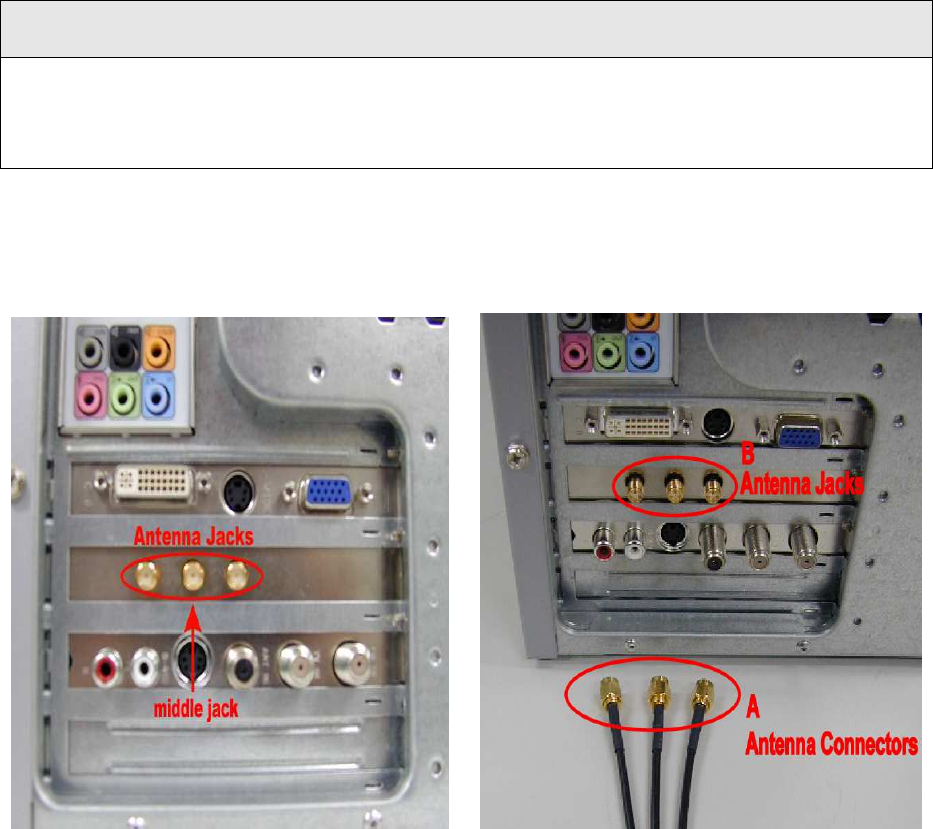
Wireless LAN 802.11a/b/g/n Device 3
2
2
A
An
nt
te
en
nn
na
a
A
At
tt
ta
ac
ch
hm
me
en
nt
t
This chapter contains instructions for antenna installation.
I
Im
mp
po
or
rt
ta
an
nt
t
It is assumed that there is an existing wireless LAN network with an Internet
connection that has been set up on your computer prior to using Wireless LAN
802.11a/b/g/n Device. Please consult your ISP for further information.
If you have already attached the antenna to your PC, please skip to Chapter 3.
1.
Figure 1 shows the antenna jacks on the back of the PC and the Antenna
Connectors.
Figure 1: Antenna Jacks on PC Back and Connectors
2.
Screw the antenna connectors to the antenna jacks.
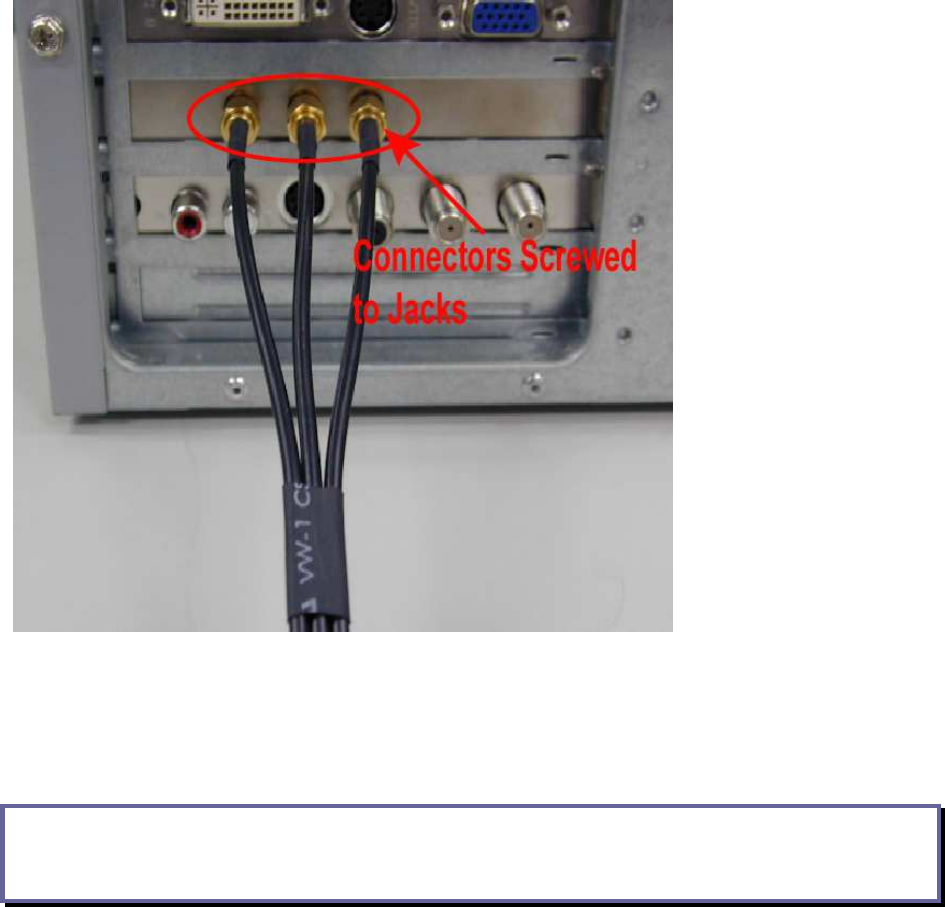
Wireless LAN 802.11a/b/g/n Device 4
Figure 2 Antenna Connectors Screwed to Jacks
3.
Place the PC on a table or place the antenna in an elevated and open area
to achieve the best wireless performance.
Note: Make sure the middle connector is screwed to the middle antenna jack to
allow the best performance. The position to which the right and left
connectors are screwed does not affect the performance.
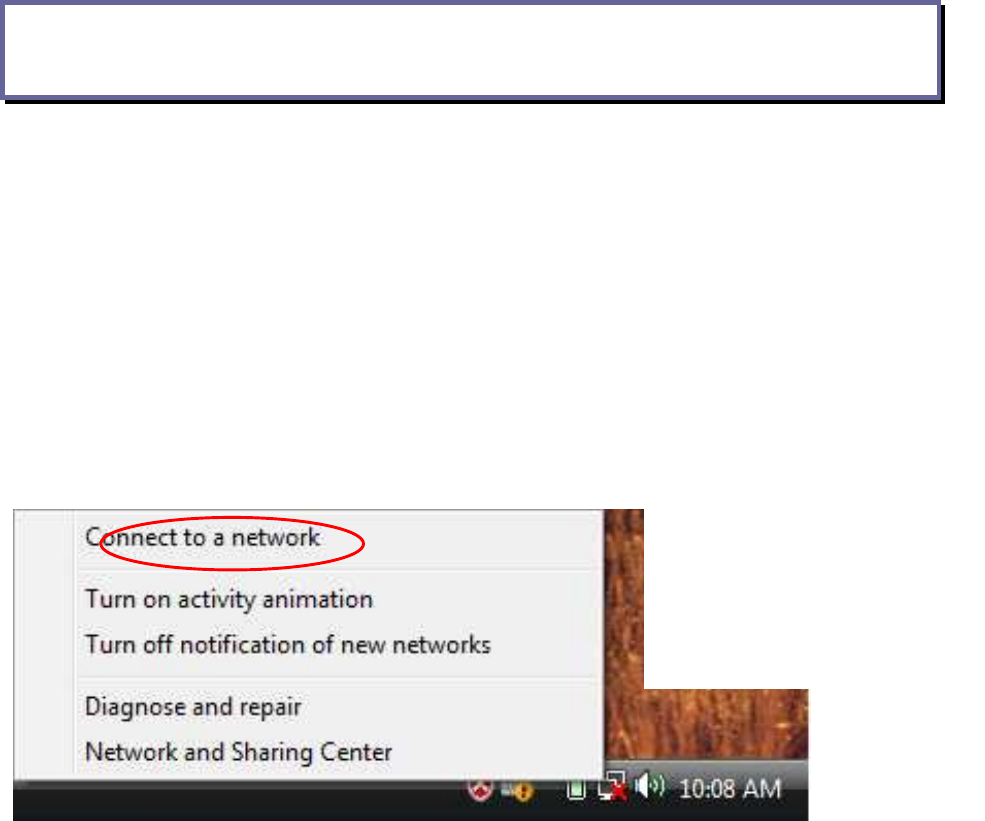
Wireless LAN 802.11a/b/g/n Device 5
3
3
W
Wi
in
nd
do
ow
ws
s
V
Vi
is
st
ta
a
W
WL
LA
AN
N
A
Au
ut
to
oC
Co
on
nf
fi
ig
g
It is necessary to complete the steps in Chapter 2 Antenna Attachment prior to
using Windows
Vista WLAN AutoConfig.
If you have already established a wireless network with access to the Internet
and you would like to wirelessly connect this PC to your wireless network, use
Windows
Vista WLAN AutoConfig.
3
3.
.1
1
L
La
au
un
nc
ch
hi
in
ng
g
M
Mi
ic
cr
ro
os
so
of
ft
t
W
Wi
in
nd
do
ow
ws
s
V
Vi
is
st
ta
a
W
WL
LA
AN
N
A
Au
ut
to
oC
Co
on
nf
fi
ig
g
To launch Windows
Vista WLAN AutoConfig:
1.
In the Systems Tray find the Wireless Networking icon.
Figure 3: Wireless Network Icon
2.
Select Connect to a network and the Wireless Network Connection dialog box
will appear.
3
3.
.2
2
S
Se
et
tt
ti
in
ng
g
t
th
he
e
N
Ne
et
tw
wo
or
rk
k
K
Ke
ey
y
A
Au
ut
to
om
ma
at
ti
ic
ca
al
ll
ly
y
The PC will begin functioning in Station Mode (as a Client) with your Wireless LAN
Network as soon as the Network Key is set-up.
Note: It is assumed that there is an existing wireless network with connection to
the Internet. If not, please consult your ISP for further information on
establishing an Internet connection.
Note: There may be multiple
Network icons in the
system tray. Choose
the one for Wireless
Network Connection
as shown.
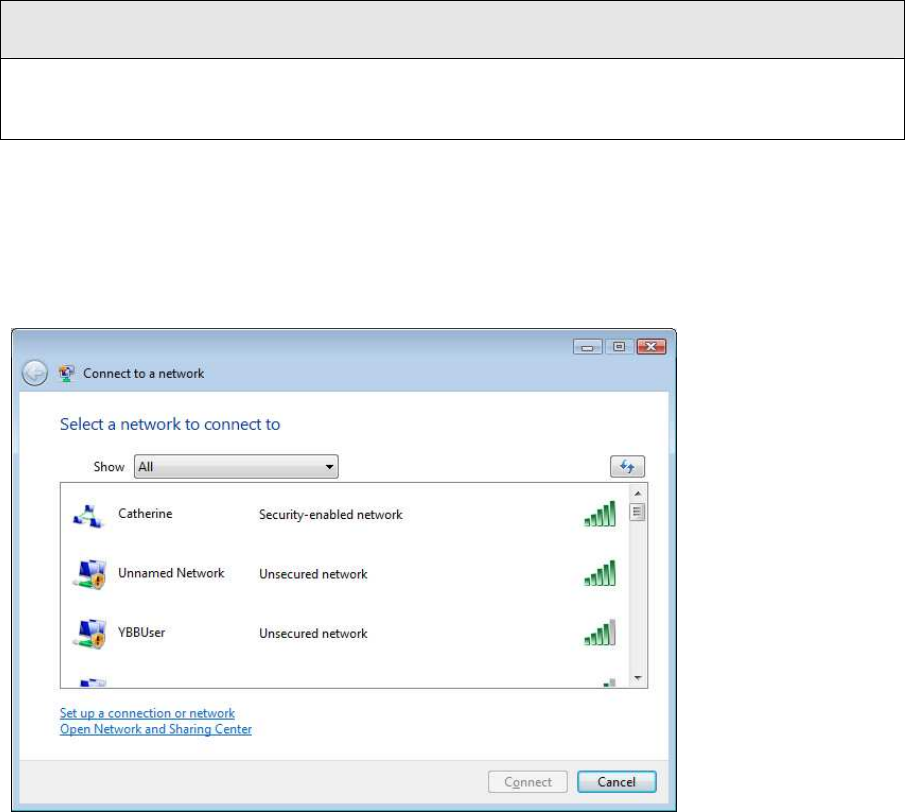
Wireless LAN 802.11a/b/g/n Device 6
I
Im
mp
po
or
rt
ta
an
nt
t
If you do not have an existing wireless network you will need to set up your
Wireless Router or Access Point prior to using your PC in Station Mode.
1.
Find the Network Key (WEP Key or WPA/WPA2 Key) for your Wireless Network.
2.
Select View Available Wireless Networks from the Wireless Network icon menu.
3.
The Wireless Network Connection dialog box will appear.
Figure 4: Wireless Network Connection dialog box
4.
Select the Wireless Network of your choice by clicking on its name and the
entire block will become highlighted.
5.
Select Connect in the lower right corner.
6.
The Wireless Network Connection dialog box will appear as shown below.
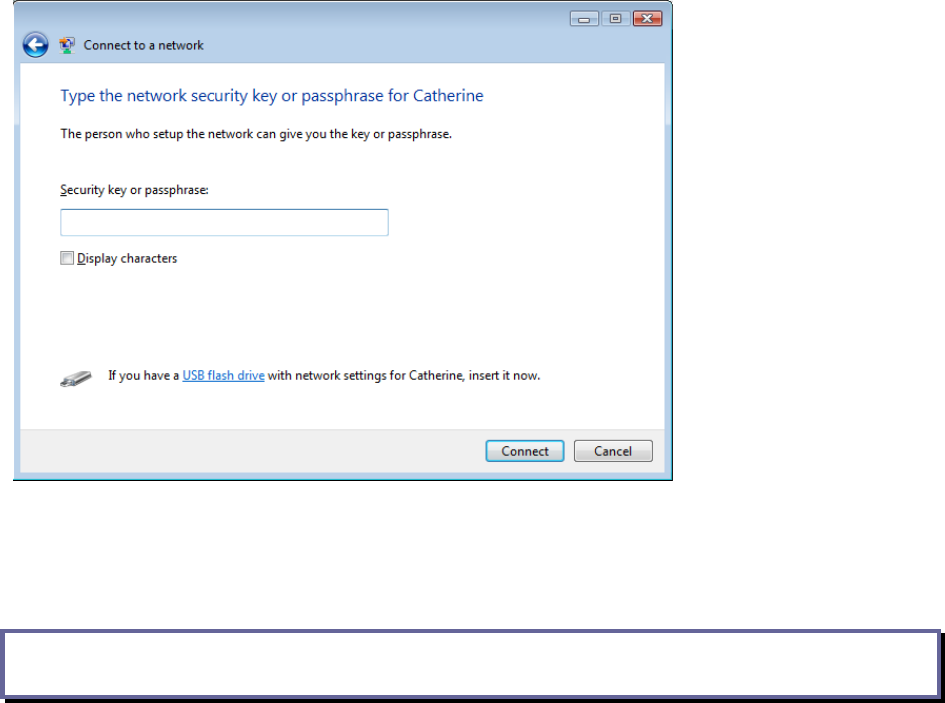
Wireless LAN 802.11a/b/g/n Device 7
Figure 5: Wireless Network Connection dialog box
7.
Enter the Network Key (WEP Key or WPA/WPA2 Key) for your Wireless Network.
HEX: Refer to 10 Characters in HEX notation for 40 bit or 26 characters for
128 bit encryption.
ASCII: Refer to 5 characters for 40 bit or 13 characters for 128 bit
encryption.
If your network is using WPA/WPA2, it is necessary to enter an 8 to 63 character
alphanumeric key-phrase. The Network Key will accept any of these as it
supports both WEP and WPA/WPA2.
8.
Select Connect in Figure 5.
9.
The Wireless Network Connection dialog box appears as you are being
connected.
Note: If your network is using WEP encryption, a HEX or an ASCEII formats is
necessary when entering your Network key.
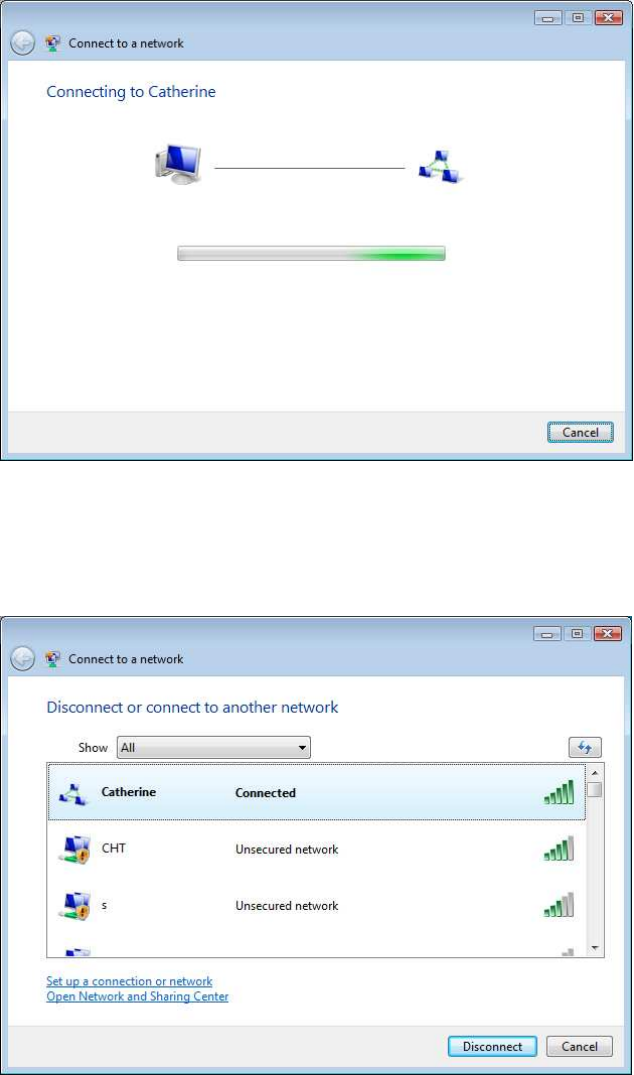
Wireless LAN 802.11a/b/g/n Device 8
Figure 6: Connecting to Wireless dialog box
After connection to the network is established, the Wireless Network Connection
dialog box will reappear showing the connection status as shown in Figure 7.
Figure 7: Wireless Network Connection dialog box
3
3.
.3
3
S
Se
et
tt
ti
in
ng
g
t
th
he
e
N
Ne
et
tw
wo
or
rk
k
K
Ke
ey
y
M
Ma
an
nu
ua
al
ll
ly
y
After launching the application (See Section 3.1, Launching the application), you
will need to input the Network name and Network Key. The Network name and
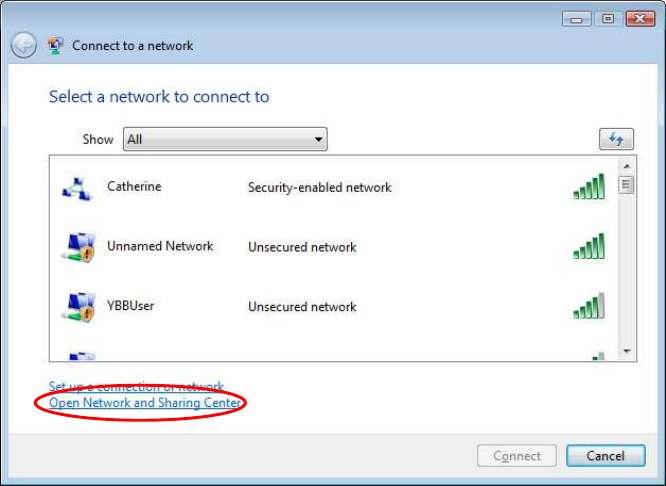
Wireless LAN 802.11a/b/g/n Device 9
Network Key must both be set up for your PC to function with your current network
in Station Mode.
Before manually setting up the Network name and Network Key on your PC, you
must identify this information on your current wireless network:
Network name (SSID)
Security WPA-PSK Key OR Security WEP Key
The Wireless Network Connection dialog box appears when you have launched
Windows
Vista WLAN AutoConfig:
Figure 8: Wireless Network Connection dialog box
1.
Choose your Wireless Network in the Available wireless networks selection box.
Your network will become highlighted.
2.
Click “Open Network and Sharing Center” in the lower left corner, the Open
Network and Sharing Center window appears.
Note: Your Network name
will appear in the Available
wireless networks box. Any
other listed available
wireless networks represent
the wireless networks
established within range of
your PC. These will vary and
do not provide secured
access to the Internet.
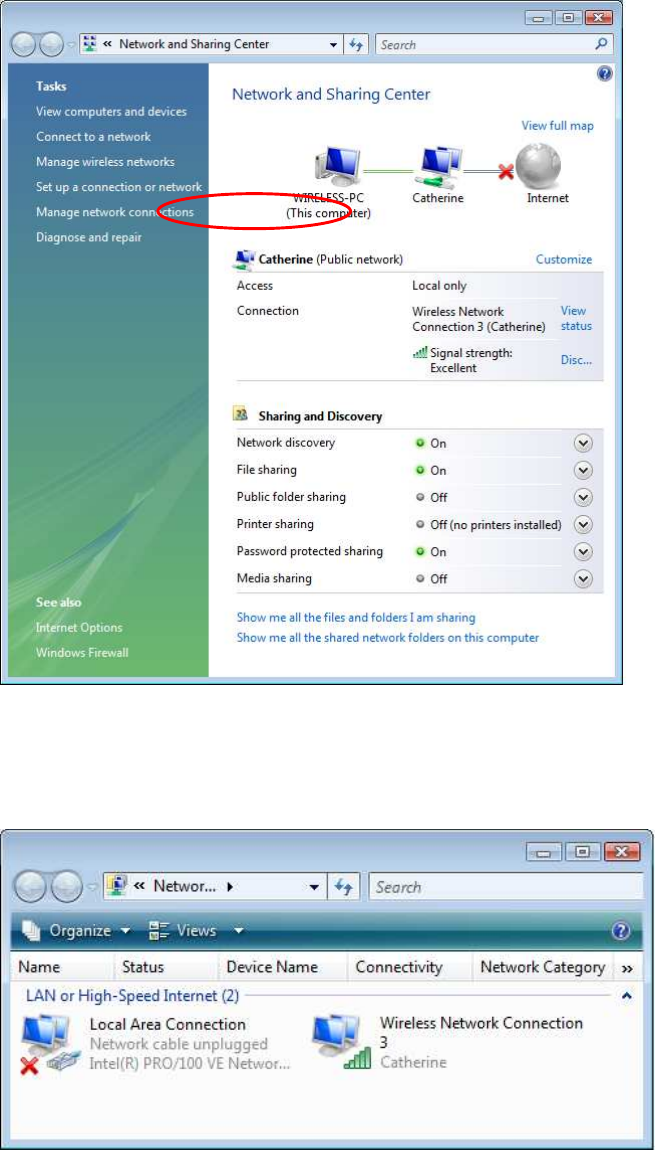
Wireless LAN 802.11a/b/g/n Device 10
Figure 9: Network and Sharing Center dialog box
3.
Click Manage network connections under Tasks on the left side, the Network
Connections window appears.
Figure 10: Network Connection dialog box
4.
Right click your wireless connection icon and select Properties, click Continue
in the User Account Control window (this function is open by default), the
Wireless Network Connection Properties dialog box appears.
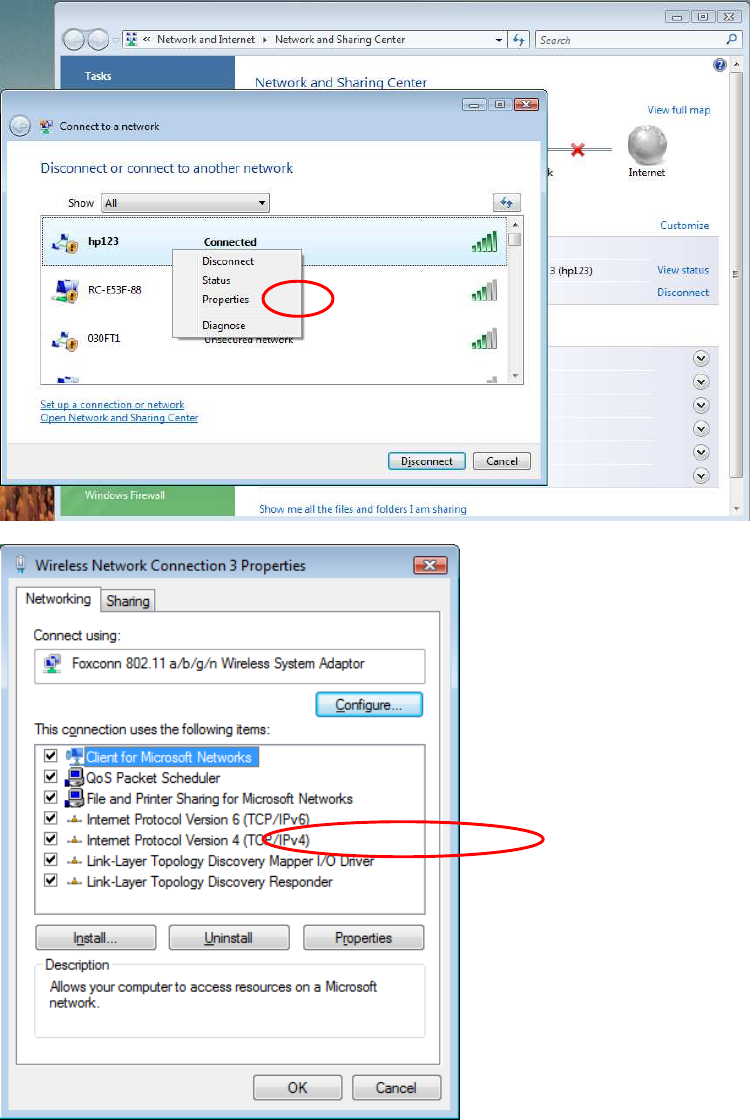
Wireless LAN 802.11a/b/g/n Device 11
Figure 11: Wireless Network Connection Properties dialog box
5.
Select Internet Protocol Version 4 (TCP/IPv4) then click Properties, the Internet
Protocol Version 4 (TCP/IP) Properties dialog box appears.
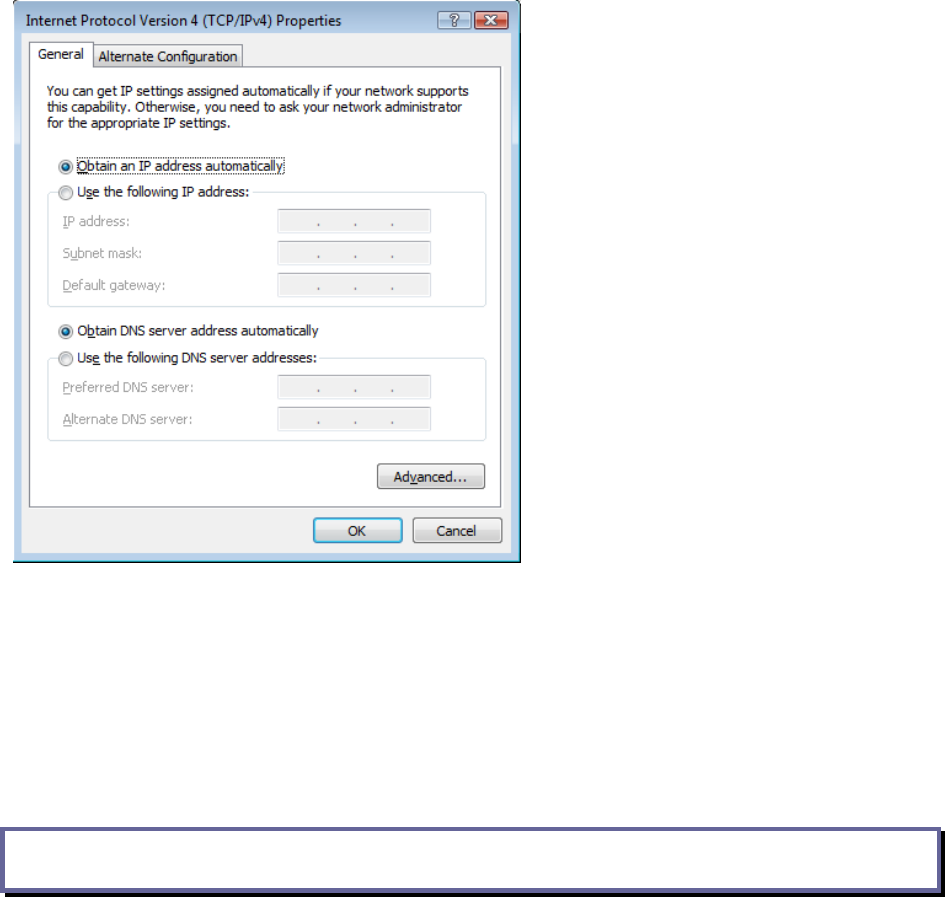
Wireless LAN 802.11a/b/g/n Device 12
Figure 12: Internet Protocol Version 4 (TCP/IPv4) Properties dialog box
6.
Verify that the following choices are selected:
Obtain an IP address automatically
Obtain DNS server address automatically
7.
Select OK.
You are returned to the Wireless Network Connection Properties dialog box.
For instructions on how to set security, refer to Section 3.3.1 to 3.3.5.
3
3.
.3
3.
.1
1
N
No
o
a
au
ut
th
he
en
nt
ti
ic
ca
at
ti
io
on
n
(
(O
Op
pe
en
n)
):
:
S
Se
et
tt
ti
in
ng
g
t
th
he
e
N
Ne
et
tw
wo
or
rk
k
K
Ke
ey
y
(
(N
Ne
et
tw
wo
or
rk
k
S
Se
ec
cu
ur
ri
it
ty
y)
)
This section gives instruction on how to correctly set up No authentication (Open)
security on your PC.
In order to set up your Network Key (security feature) you will need to do the
following:
Note: Obtaining an IP address automatically is recommended. If static IP address
settings are preferred, refer to your own wireless network settings.
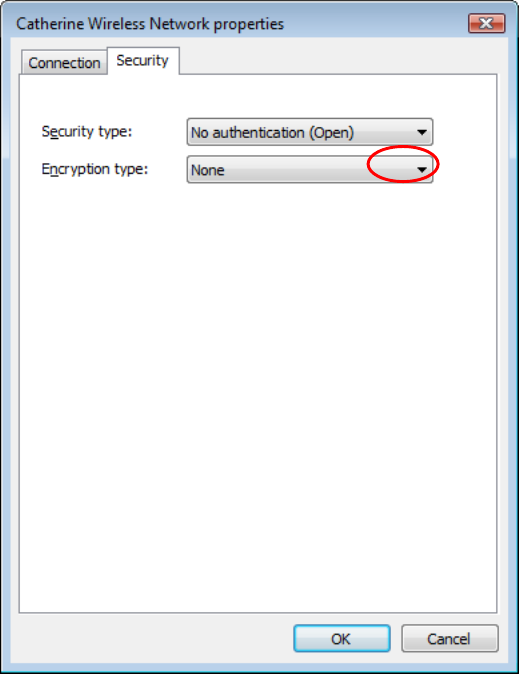
Wireless LAN 802.11a/b/g/n Device 13
1.
Open the Wireless Network Connection Properties dialog box:
Right click on the Wireless Networks icon in the system tray.
Select Network and Sharing Center from the Wireless Networks I
con menu.
The Network and Sharing Center dialog box appears.
Click Connect to a network on the left side of the dialog box.
The Disconnect or connect to another network dialog box appears.
Select the wireless connection that you want to set the network security key.
Right click the network connection and select Properties, Wireless Network
Properties dialog box appears shown as below. Make sure Security tab is
selected.
Figure 13: Wireless Network Properties Dialog Box
2.
Select “None” and you don’t need to set security code. Click OK.
3.
Select WEP in the Encryption type selection box then Network security key box
will appear.
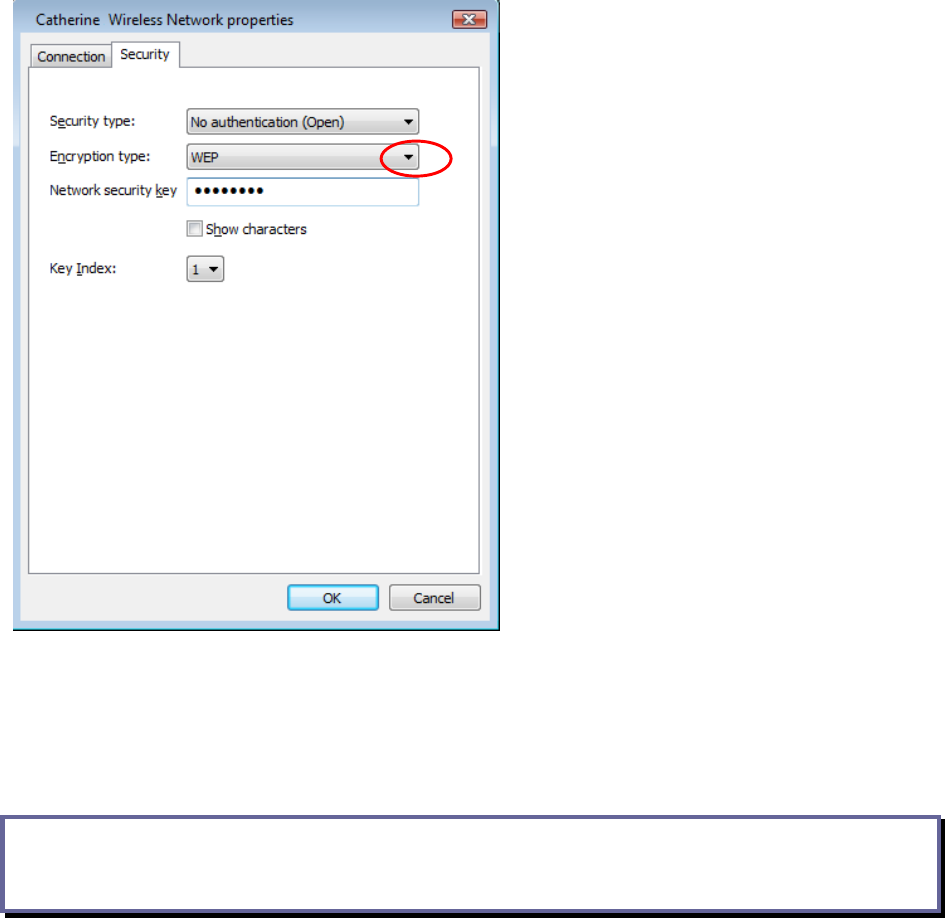
Wireless LAN 802.11a/b/g/n Device 14
Figure 14: Wireless Network Properties dialog box
4.
Verify that the Data Encryption is set to WEP.
5.
Input the Network security key then click OK.
HEX: 10 characters in HEX notation for 40 bit, or 26 characters for 128 bit.
ASCII: 5 characters for 40 bit, 13 characters for 128 bit.
You are returned to the Wireless Network Connection Properties dialog box and
are able to verify your connection.
3
3.
.3
3.
.2
2
S
Sh
ha
ar
re
ed
d:
:
S
Se
et
tt
ti
in
ng
g
t
th
he
e
N
Ne
et
tw
wo
or
rk
k
K
Ke
ey
y
(
(N
Ne
et
tw
wo
or
rk
k
S
Se
ec
cu
ur
ri
it
ty
y)
)
This section gives instruction on how to correctly set up Shared security on your
PC.
In order to set up your Network Key (Shared security feature) you will need to do
the following:
Note: Either a HEX or ASCII format is necessary when using the WEP interface.
Your WEP enabled device should already have either HEX or ASCII format
pass-phrase associated.
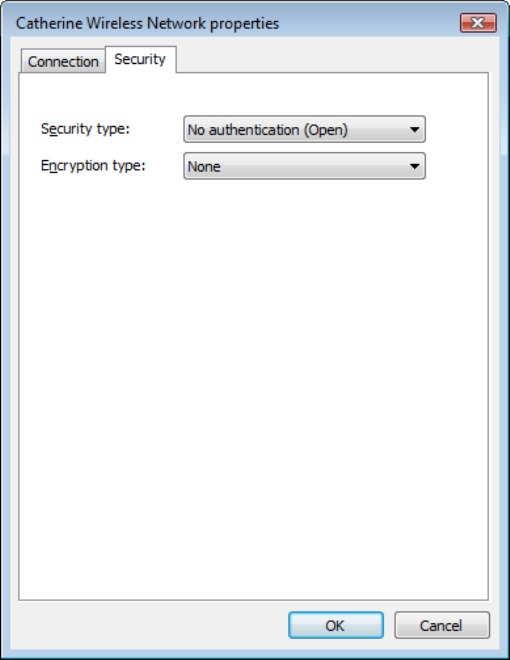
Wireless LAN 802.11a/b/g/n Device 15
1.
Open the Wireless Network Connection Properties dialog box:
Right click on the Wireless Networks icon in the system tray.
Select Network and Sharing Center from the Wireless Networks icon menu.
The Network and Sharing Center dialog box appears.
Click Connect to a network on the left side of the dialog box.
The Disconnect or connect to another network dialog box appears.
Select the wireless connection that you want to set the network security key.
Right click the network connection and select Properties, Wireless Network
Properties dialog box appears shown as below. Make sure Security tab is
selected.
Figure 15: Wireless Network Properties Dialog Box
2.
Select Shared in the Encryption type selection box then Network security key
box will appear.
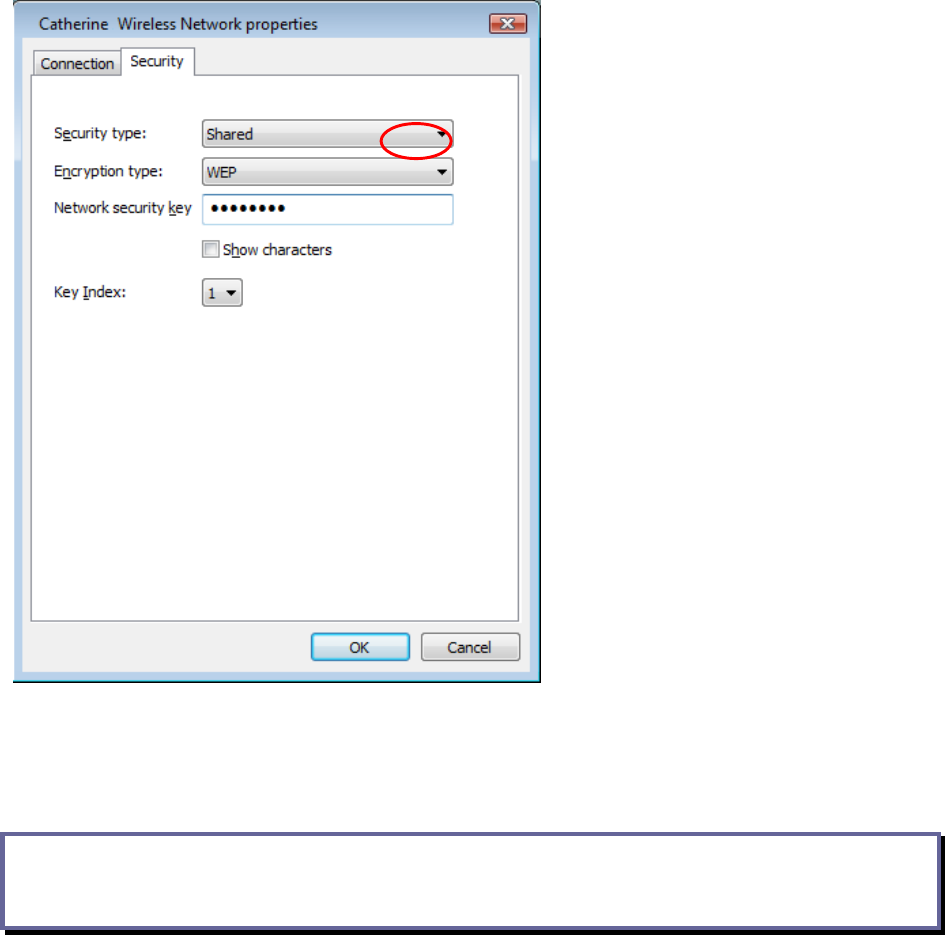
Wireless LAN 802.11a/b/g/n Device 16
Figure 16: Wireless Network Properties dialog box
3.
Input the Network security key then click OK.
HEX: 10 characters in HEX notation for 40 bit, or 26 characters for 128 bit.
ASCII: 5 characters for 40 bit or 13 characters for 128 bit.
You are returned to the Wireless Network Connection Properties dialog box and
are able to verify your connection.
Note: Either a HEX or ASCII format is necessary when using the WEP interface.
Your WEP enabled device should already have either HEX or ASCII format
pass-phrase associated.
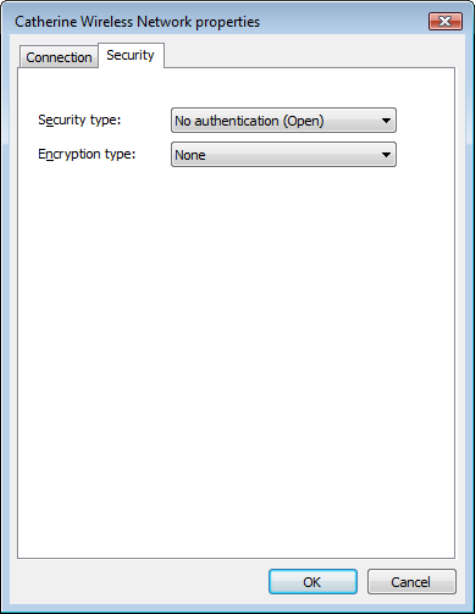
Wireless LAN 802.11a/b/g/n Device 17
3
3.
.3
3.
.3
3
W
WP
PA
A-
-P
Pe
er
rs
so
on
na
al
l
O
Or
r
W
WP
PA
A2
2-
-P
Pe
er
rs
so
on
na
al
l:
:
S
Se
et
tt
ti
in
ng
g
t
th
he
e
N
Ne
et
tw
wo
or
rk
k
K
Ke
ey
y
(
(N
Ne
et
tw
wo
or
rk
k
S
Se
ec
cu
ur
ri
it
ty
y)
)
This section gives instruction on how to correctly set up WPA2-Personal or
WPA-Personal security on your PC.
In order to set up your Network Key (WPA2-Personal or WPA-Personal security
feature) you will need to do the following:
1.
Open the Wireless Network Connection Properties dialog box:
Right click on the Wireless Networks icon in the system tray.
Select Network and Sharing Center from the Wireless Networks I
con menu.
The Network and Sharing Center dialog box appears.
Click Connect to a network on the left side of the dialog box.
The Disconnect or connect to another network dialog box appears.
Select the wireless connection that you want to set the network security key.
Right click the network connection and select Properties, Wireless Network
Properties dialog box appears shown as below. Make sure Security tab is
selected.
Figure 17: Wireless Network Properties Dialog Box
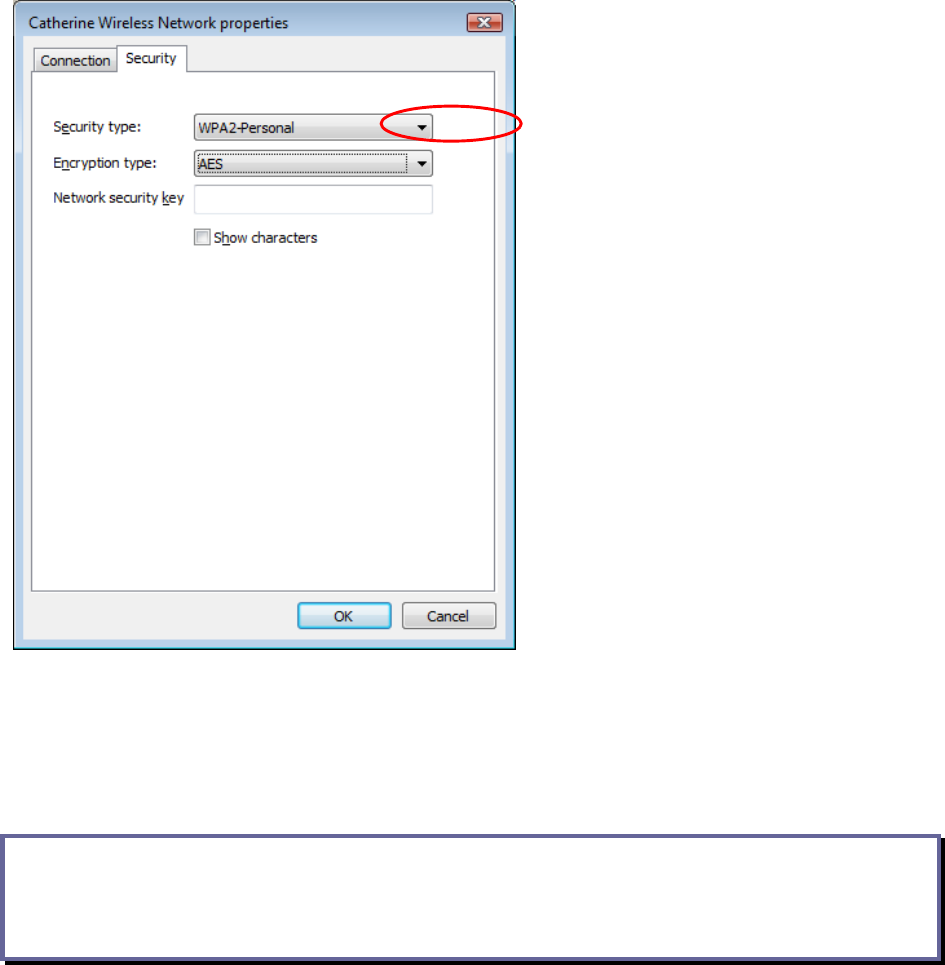
Wireless LAN 802.11a/b/g/n Device 18
2.
Select WPA-Personal or WPA2-Personal in the Security type selection box then
Wireless Network properties dialog box appears.
Figure 18: Wireless Network Properties dialog box
3.
Verify that the Encryption type is set to TKIP or AES.
4.
Input the Network security key then click OK.
HEX: 10 characters in HEX notation for 40 bit, or 26 characters for 128 bit.
ASCII: 5 characters for 40 bit, 13 characters for 128 bit.
You are returned to the Wireless Network Connection Properties dialog box and
are able to verify your connection.
Note: An 8-to-63 character alphanumeric key-phrase is necessary when using
the WPA/WPA2 interface. WPA/WPA2 does not require HEX or ASCII
notation common with WEP keys. Your WPA/WPA2 enabled device should
already have an 8 to 63 character alphanumeric key-phrase.
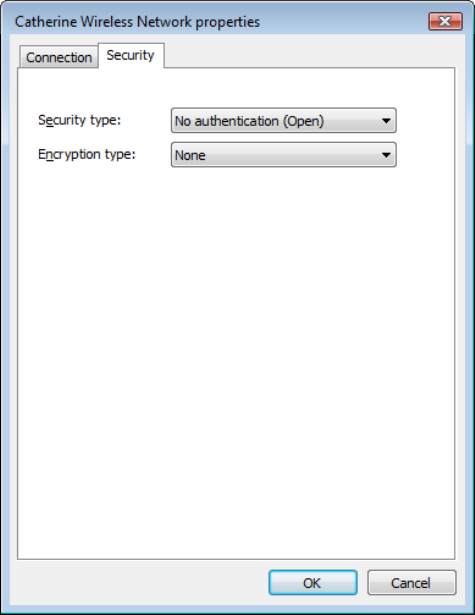
Wireless LAN 802.11a/b/g/n Device 19
3
3.
.3
3.
.4
4
W
WP
PA
A-
-E
En
nt
te
er
rp
pr
ri
is
se
e
O
Or
r
W
WP
PA
A2
2-
-E
En
nt
te
er
rp
pr
ri
is
se
e:
:
S
Se
et
tt
ti
in
ng
g
t
th
he
e
N
Ne
et
tw
wo
or
rk
k
K
Ke
ey
y
(
(N
Ne
et
tw
wo
or
rk
k
S
Se
ec
cu
ur
ri
it
ty
y)
)
This section gives instruction on how to correctly set up WPA-Enterprise OR
WPA2-Enterprise security on your PC.
In order to set up your Network Key (WPA-Enterprise Or WPA2-Enterprise security
feature) you will need to do the following:
1.
Open the Wireless Network Connection Properties dialog box:
Right click on the Wireless Networks icon in the system tray.
Select Network and Sharing Center from the Wireless Networks I
con menu.
The Network and Sharing Center dialog box appears.
Click Connect to a network on the left side of the dialog box.
The Disconnect or connect to another network dialog box appears.
Select the wireless connection that you want to set the network security key.
Right click the network connection and select Properties, Wireless Network
Properties dialog box appears shown as below. Make sure Security tab is
selected.
Figure 19: Wireless Network Properties Dialog Box
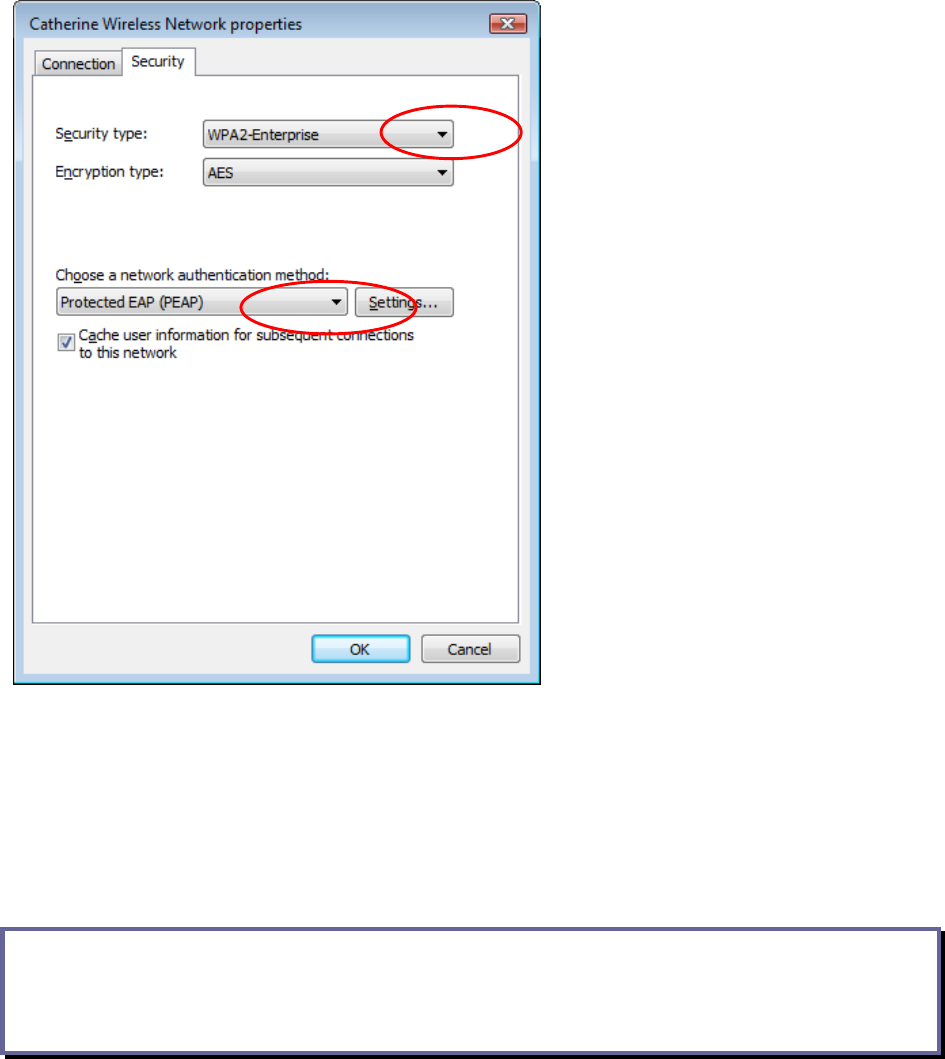
Wireless LAN 802.11a/b/g/n Device 20
2.
Select WPA-Enterprise or WPA2-Enterprise in the Security type selection box
then Wireless Network properties dialog box appears.
Figure 20: Wireless Network Properties dialog box
3.
Verify that the Network Authentication method is set to Protected EAP (PEAP) or
Smart Card or other certificate.
4.
Verify that the Encryption type is set to TKIP or AES.
5.
Input the Network security key then click OK.
HEX: 10 characters in HEX notation for 40 bit, or 26 characters for 128 bit.
ASCII: 5 characters for 40 bit, 13 characters for 128 bit.
You are returned to the Wireless Network Connection Properties dialog box and
are able to verify your connection.
Note: An 8-to-63 character alphanumeric key-phrase is necessary when using
the WPA/WPA2 interface. WPA/WPA2 does not require HEX or ASCII
notation common with WEP keys. Your WPA/WPA2 enabled device should
already have an 8 to 63 character alphanumeric key-phrase.
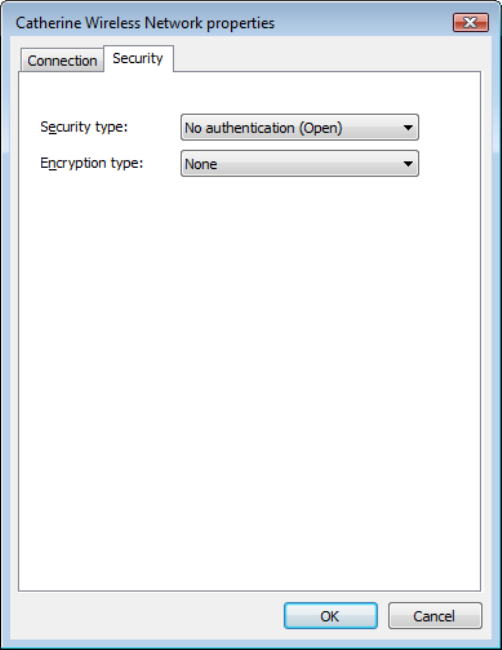
Wireless LAN 802.11a/b/g/n Device 21
3
3.
.3
3.
.5
5
8
80
02
2.
.1
1X
X:
:
S
Se
et
tt
ti
in
ng
g
t
th
he
e
N
Ne
et
tw
wo
or
rk
k
K
Ke
ey
y
(
(N
Ne
et
tw
wo
or
rk
k
S
Se
ec
cu
ur
ri
it
ty
y)
)
This section gives instruction on how to correctly set up 802.1X security on your
PC.
In order to set up your Network Key (802.1X security feature) you will need to do
the following:
1.
Open the Wireless Network Connection Properties dialog box:
Right click on the Wireless Networks icon in the system tray.
Select Network and Sharing Center from the Wireless Networks I
con menu.
The Network and Sharing Center dialog box appears.
Click Connect to a network on the left side of the dialog box.
The Disconnect or connect to another network dialog box appears.
Select the wireless connection that you want to set the network security key.
Right click the network connection and select Properties, Wireless Network
Properties dialog box appears shown as below. Make sure Security tab is
selected.
Figure 21: Wireless Network Properties Dialog Box
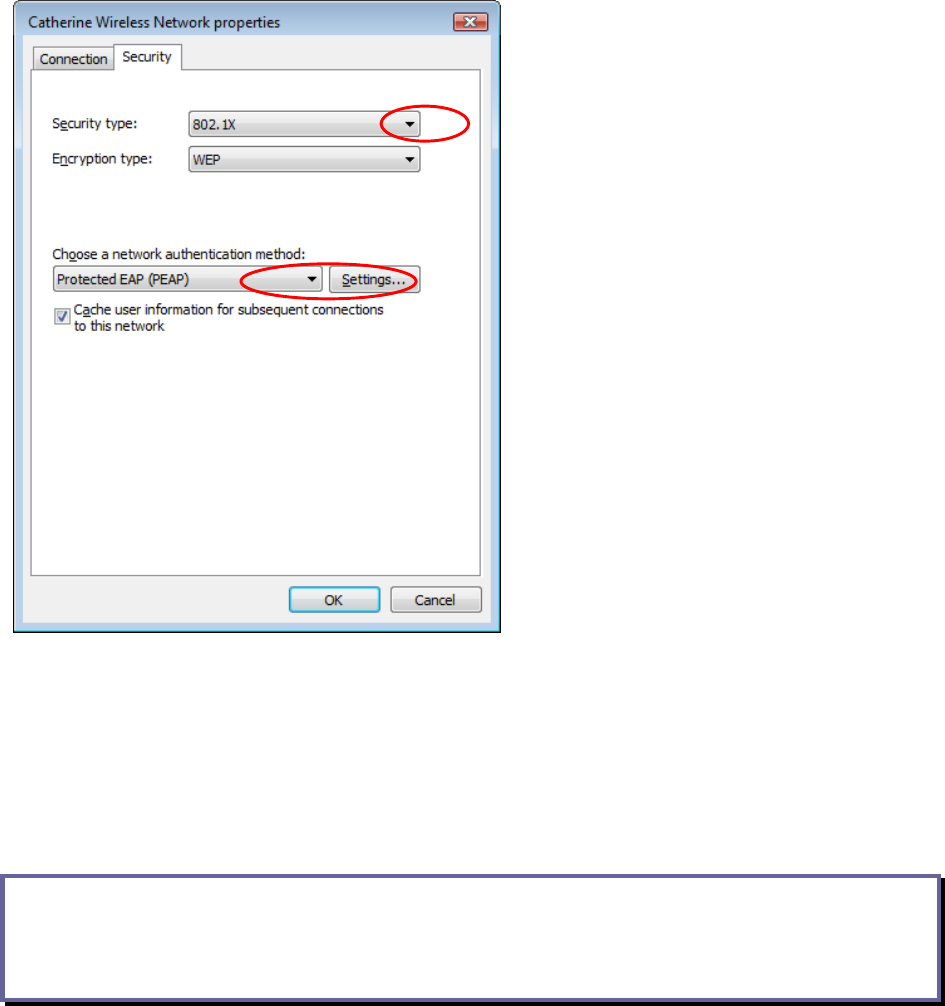
Wireless LAN 802.11a/b/g/n Device 22
2.
Select 802.1X in the Security type selection box then Wireless Network
properties dialog box appears.
Figure 22: Wireless Network Properties dialog box
3.
Verify that the Network Authentication method is set to Protected EAP (PEAP) or
Smart Card or other certificate.
4.
Verify that the Encryption type is set to TKIP or AES.
5.
Input the Network security key then click OK.
HEX: 10 characters in HEX notation for 40 bit, or 26 characters for 128 bit.
ASCII: 5 characters for 40 bit, or 13 characters for 128 bit.
You are returned to the Wireless Network Connection Properties dialog box and
are able to verify your connection.
Note: An 8-to-63 character alphanumeric key-phrase is necessary when using
the WPA/WPA2 interface. WPA/WPA2 does not require HEX or ASCII
notation common with WEP keys. Your WPA/WPA2 enabled device should
already have an 8 to 63 character alphanumeric key-phrase.

Wireless LAN 802.11a/b/g/n Device 23
Terms
T
Te
er
rm
ms
s
D
De
ef
fi
in
ni
it
ti
io
on
n
Access Point (AP) A hardware device (possibly a PC) that can act as a
communication hub for wireless devices enabling them to
connect to a wired LAN (Local Area Network) or to one another.
ASCII (American
Standard Code for
Information
Interchange)
A code used for encryption that represents letters with numbers.
Broadband Router A device that lets multiple client devices share a single internet
connection (like DSL, Cable modem or T1). Generally Broadband
Routers offer rudimentary network address translations and
firewall features.
Client A device that acquires networking services from another device
like another PC or access point.
DNS Server Domain Name System / Service / Server is a service available on
the internet that translates domain names into IP addresses.
Encryption The most efficient way to achieve data security online.
Encryption is a method of coding data. Generally it is necessary
to provide a secret key or password in order to receive decoded
information when encrypted.
Router A gate or entrance into a network. The ISP connecting a home to
the internet is generally the router in a residence.
HEX A numbering system used in encryption. HEX is a 16 symbol
system consisting of the numbers 0 – 9 and A – F.
IP Address An address that identifies devices on a TCP/IP network (eg;
192.168.0.2).
ISP (Internet Service
Provider) A company that provides access to the internet.

Wireless LAN 802.11a/b/g/n Device 24
T
Te
er
rm
ms
s
D
De
ef
fi
in
ni
it
ti
io
on
n
MAC Address Media Access Control Address. On an 802.11 network the MAC
address is used to identify each node of the network.
Network Name See SSID.
Network Key Network password.
SSID (Service Set
Identifier) The unique identifier attached to the header of packets sent over
a Wireless Local Area Network (WLAN). The SSID differentiates
Wireless LANs from one another. For this reason an SSID must
be entered on each wireless device attempting to connect on the
WLAN.
Station See Client.
WEP Wired Equivalency Protocol. WEP is an 802.11 encryption
standard that provides security for wireless LANs.
Wireless LAN A wireless version of Ethernet, the Wireless Local Area Network
enables wireless internet access through your or broadband
router.
Wireless Network See Wireless LAN.
WPA Wi-Fi Protected Access. WPA is an addition to the security in the
802.11 standard. It is an enhancement to the original security
implementation for 802.11 devices.
WPA2 WPA2 is the next generation of Wi-Fi security. It is the Wi-Fi
Alliance's interoperable implementation of the ratified IEEE
802.11i standard.
WPA Personal AES (Advanced Encryption Standard). See WPA/WPA2.
WPA Personal TKIP (Temporal Key Integrity Protocol). See WPA/WPA2.
Wireless LAN 802.11a/b/g/n Device 25

Wireless LAN 802.11a/b/g/n Device 26
4
4
A
Ap
pp
pe
en
nd
di
ix
x
A
A:
:
T
Tr
ro
ou
ub
bl
le
es
sh
ho
oo
ot
ti
in
ng
g
P
Pr
ro
ob
bl
le
em
m
R
Re
ec
co
om
mm
me
en
nd
de
ed
d
S
So
ol
lu
ut
ti
io
on
n
Verify that your Network Keys are entered
correctly.
If the problem persists…………
My WPA/WPA2 security settings are
not working properly.
Reconfigure your wireless network setting
to WEP security.
Verify your Network name and Security
settings.
If the problem persists………
I am unable to see my Network
name in the Available wireless
networks section of the Wireless
Network Connection dialog box on
my PC.
Consult the user’s manual for your
Wireless Router or Access Point.
I am having difficulty with my VPN
connection.
Check your VPN server for related
problems.
Internet Gaming issues For assistance with Internet gaming issues
please refer to Microsoft’s internet
gaming site.
Wireless LAN 802.11a/b/g/n Device 27
5
5
A
Ap
pp
pe
en
nd
di
ix
x
B
B:
:
R
Re
eg
gu
ul
la
at
to
or
ry
y
N
No
ot
ti
ic
ce
es
s
Regulatory Notices
To identify this product refer to the part or model number on the product label
Federal Communication Commission Notices
This equipment has been tested and found to comply with the limits for a Class B
digital device, pursuant to Part 15 of the FCC Rules. These limits are designed to
provide reasonable protection against harmful interference in a residential
installation. This equipment generates, uses and can radiate radio frequency
energy and, if not installed and used in accordance with the instructions, may
cause harmful interference to radio communications. However, there is no
guarantee that interference will not occur in a particular installation. If this
equipment does cause harmful interference to radio or television reception,
which can be determined by turning the equipment off and on, the user is
encouraged to try to correct the interference by one of the following measures:
- Reorient or relocate the receiving antenna.
- Increase the separation between the equipment and receiver.
- Connect the equipment into an outlet on a circuit different from that
to which the receiver is connected.
- Consult the dealer or an experienced radio/TV technician for help.
This device complies with Part 15 of the FCC Rules. Operation is subject to the
following two conditions: (1) This device may not cause harmful interference,
and (2) this device must accept any interference received, including
interference that may cause undesired operation.
FCC Caution: Any changes or modifications not expressly approved by the party
responsible for compliance could void the user's authority to operate this
equipment.
Wireless LAN 802.11a/b/g/n Device 28
For operation within 5.15 ~ 5.25GHz frequency range, it is restricted to indoor
environment.
IMPORTANT NOTE:
FCC Radiation Exposure Statement:
This equipment complies with FCC radiation exposure limits set forth for an
uncontrolled environment. This equipment should be installed and operated with
minimum distance 20cm between the radiator & your body.
This transmitter must not be co-located or operating in conjunction with any other
antenna or transmitter.
The availability of some specific channels and/or operational frequency bands
are country dependent and are firmware programmed at the factory to match
the intended destination. The firmware setting is not accessible by the end user.
European Notices
EC Conformance Declaration
This device complies with the Essential Requirements of the R&TTE Directive of the
European Union (1999/5/EC). This equipment meets the following conformance
standards:
EN 60950-1 - Product Safety
EN 300 328 - Technical requirements for 2.4 GHz radio equipment
EN 301 893 – Technical requirements for 5GHz radio equipment
EN 301 489-1 / EN 301 489-17 - EMC requirements for radio equipment
Declaration of Conformity in Languages of the European Community
English Hereby, Hon Hai Precision Ind. Co., Ltd., declares that this Radio
LAN device is in compliance with the essential requirements and
other relevant provisions of Directive 1999/5/EC.
Wireless LAN 802.11a/b/g/n Device 29
Finnish Valmistaja Hon Hai Precision Ind. Co., Ltd. vakuuttaa täten että
Radio LAN device tyyppinen laite on direktiivin 1999/5/EY
oleellisten vaatimusten ja sitä koskevien direktiivin muiden ehtojen
mukainen.
Dutch Hierbij verklaart Hon Hai Precision Ind. Co., Ltd. dat het toestel
Radio LAN device in overeenstemming is met de essentiële eisen
en de andere relevante bepalingen van richtlijn 1999/5/EG.
Bij deze Hon Hai Precision Ind. Co., Ltd. dat deze Radio LAN
device voldoet aan de essentiële eisen en aan de overige
relevante bepalingen van Richtlijn 1999/5/EC.
French Par la présente Hon Hai Precision Ind. Co., Ltd. déclare que
l'appareil Radio LAN device est conforme aux exigences
essentielles et aux autres dispositions pertinentes de la directive
1999/5/CE.
Swedish Härmed intygar Hon Hai Precision Ind. Co., Ltd. att denna Radio
LAN device står I överensstämmelse med de väsentliga
egenskapskrav och övriga relevanta bestämmelser som framgår
av direktiv 1999/5/EG.
Danish Undertegnede Hon Hai Precision Ind. Co., Ltd. erklærer herved, at
følgende udstyr Radio LAN device overholder de væsentlige krav
og øvrige relevante krav i direktiv 1999/5/EF.
German Hiermit erklärt Hon Hai Precision Ind. Co., Ltd., dass sich
dieser/diese/dieses Managed Accces Point in Übereinstimmung
mit den grundlegenden Anforderungen und den anderen
relevanten Vorschriften der Richtlinie 1999/5/EG befindet". (BMWi)
Hiermit erklärt Hon Hai Precision Ind. Co., Ltd. die
Übereinstimmung des Gerätes RLAN device mit den
grundlegenden Anforderungen und den anderen relevanten
Festlegungen der Richtlinie 1999/5/EG. (Wien)
Greek ΜΕ ΤΗΝ ΠΑΡΟΥΣΑ Hon Hai Precision Ind. Co., Ltd. ∆ΗΛΩΝΕΙ ΟΤΙ
RLAN device ΣΥΜΜΟΡΦΩΝΕΤΑΙ ΠΡΟΣ ΤΙΣ ΟΥΣΙΩ∆ΕΙΣ ΑΠΑΙΤΗΣΕΙΣ
Wireless LAN 802.11a/b/g/n Device 30
ΚΑΙ ΤΙΣ ΛΟΙΠΕΣ ΣΧΕΤΙΚΕΣ ∆ΙΑΤΑΞΕΙΣ ΤΗΣ Ο∆ΗΓΙΑΣ 1999/5/ΕΚ
Italian Con la presente Hon Hai Precision Ind. Co., Ltd. dichiara che
questo Radio LAN device è conforme ai requisiti essenziali ed alle
altre disposizioni pertinenti stabilite dalla direttiva 1999/5/CE.
Spanish Por medio de la presente Hon Hai Precision Ind. Co., Ltd. declara
que el Radio LAN device cumple con los requisitos esenciales y
cualesquiera otras disposiciones aplicables o exigibles de la
Directiva 1999/5/CE.
Portuguese Hon Hai Precision Ind. Co., Ltd. declara que este Radio LAN
device está conforme com os requisitos essenciais e outras
disposições da Directiva 1999/5/CE.
Malti Hawnhekk, Hon Hai Precision Ind. Co., Ltd., jiddikjara li dan RLAN
device jikkonforma mal-ħtiġijiet essenzjali u ma provvedimenti
oħrajn relevanti li hemm fid-Dirrettiva 1999/5/EC
Estonian Käesolevaga kinnitab Hon Hai Precision Ind. Co., Ltd. seadme
RLAN device vastavust direktiivi 1999/5/EÜ põhinõuetele ja
nimetatud direktiivist tulenevatele teistele asjakohastele sätetele.
Hungarian Alulírott, Hon Hai Precision Ind. Co., Ltd. nyilatkozom, hogy a RLAN
device megfelel a vonatkozó alapvetõ követelményeknek és az
1999/5/EC irányelv egyéb elõírásainak.
Slovak Hon Hai Precision Ind. Co., Ltd. týmto vyhlasuje, že RLAN device
spĺňa základné požiadavky a všetky príslušné ustanovenia
Smernice 1999/5/ES.
Czech Hon Hai Precision Ind. Co., Ltd. tímto prohlašuje, že tento RLAN
device je ve shodě se základními požadavky a dalšími příslušnými
ustanoveními směrnice 1999/5/ES.
Slovene Šiuo Hon Hai Precision Ind. Co., Ltd. deklaruoja, kad šis RLAN
device atitinka esminius reikalavimus ir kitas 1999/5/EB Direktyvos
nuostatas.
Wireless LAN 802.11a/b/g/n Device 31
Lithuanian Šiuo Hon Hai Precision Ind. Co., Ltd. deklaruoja, kad šis RLAN
device atitinka esminius reikalavimus ir kitas 1999/5/EB Direktyvos
nuostatas.
Latvian Ar šo Hon Hai Precision Ind. Co., Ltd. deklarē, ka RLAN device
atbilst Direktīvas 1999/5/EK būtiskajām prasībām un citiem ar to
saistītajiem noteikumiem.
IC CAUTION
This device complies with RSS-210 of the Industry Canada Rules. Operation is
subject to the following two conditions:
1) this device may not cause interference and
2) this device must accept any interference, including interference that may
cause undesired operation of the device
This device has been designed to operate with an antenna having a maximum
gain of 1.5 dBi.
Antenna having a higher gain is strictly prohibited per regulations of Industry
Canada. The required antenna
impedance is 50 ohms.
To reduce potential radio interference to other users, the antenna type and its
gain should be so chosen that the EIRP is not more than required for successful
communication.
Caution:
The device for the band 5150-5250 MHz is only for indoor usage to reduce
potential for harmful interference to co-channel mobile satellite systems.
Wireless LAN 802.11a/b/g/n Device 32
Because high power radars are allocated as primary users (meaning they have
priority) in 5250-5350 MHz and 5650-5850 MHz, these radars could cause
interference and/or damage to license exempt LAN devices.
IMPORTANT NOTE:
IC Radiation Exposure Statement:
This equipment complies with IC radiation exposure limits set forth for an
uncontrolled environment. This equipment should be installed and operated with
minimum distance 20cm between the radiator & your body.

Wireless LAN 802.11a/b/g/n Device 33
6
6
A
Ap
pp
pe
en
nd
di
ix
x
C
C:
:
P
Pr
ro
od
du
uc
ct
t
S
Sp
pe
ec
ci
if
fi
ic
ca
at
ti
io
on
ns
s
Specifications
Model Number U98H038
Functional Criteria
Data Rate Up to 54 Mbps
Operating Range 802.11a/b/g/n: 30m (indoor)
Radio Signal
Modulation Direct Sequency Spread Spectrum (DSSS)
Orthogonal Frequency Division Multiplexing
(OFDM)
Operating Frequency
USA (FCC), Canada (IC): 2412~2462 MHz
5150~5250 MHz & 5725~5850 MHz
Europe (CE): 2412~2472 MHz
5150~5250 MHz & 5725~5850 MHz
Operating Channel
USA, Canada: 11 Channels for 802.11b/g
9 Channels for 5 GHz
Europe: 13 Channels for 802.11b/g (7 for France)

Wireless LAN 802.11a/b/g/n Device 34
9 Channels for 5 GHz
Physical Characteristics
Power Consumption TX: 810 mA Max; RX: 260 mA
Dimensions 122 x 81 x 14 mm (4.80 x 3.19 x 0.55 in.)
Antenna External Antenna
LED Indicator Power / Link(Green):
Blink: Radio on and scanning, On: Link
established
ACT(Green):
Blink: Data transmitting
Host Interface PCI specification v.2.3
Standards Conformance
Wireless Standard IEEE 802.11a/b/g/n, Wi-Fi, WPA/WPA2
Environmental
Temperature Operating: 0 to 55 °C (32 to 131 °F)
Storage: -20 to 75 °C (-4 to 167 °F)
Humidity 5 to 90% (non-condensing)
Certification

Wireless LAN 802.11a/b/g/n Device 35
Emissions EN 301489-1/-17
FCC Part 15 Subpart B
ICES-003
Safety EN60950-1
Radio EN300328, EN301893
FCC Part 15 Subpart C & Subpart E
IC RSS-210
Software Drivers
NDIS Drivers Windows Vista
Antenna Specification
Antenna Type External Antenna
Frequency Band 2.4 ~ 2.5GHz
5.15~5.25GHz & 5.725~5.85GHz
Polarization Vertical
Connector Reverse SMA Connector
Gain 802.11a/b/g/n:
Peak gain: 1.5 dBi
Radiation Omni-directional
7
7